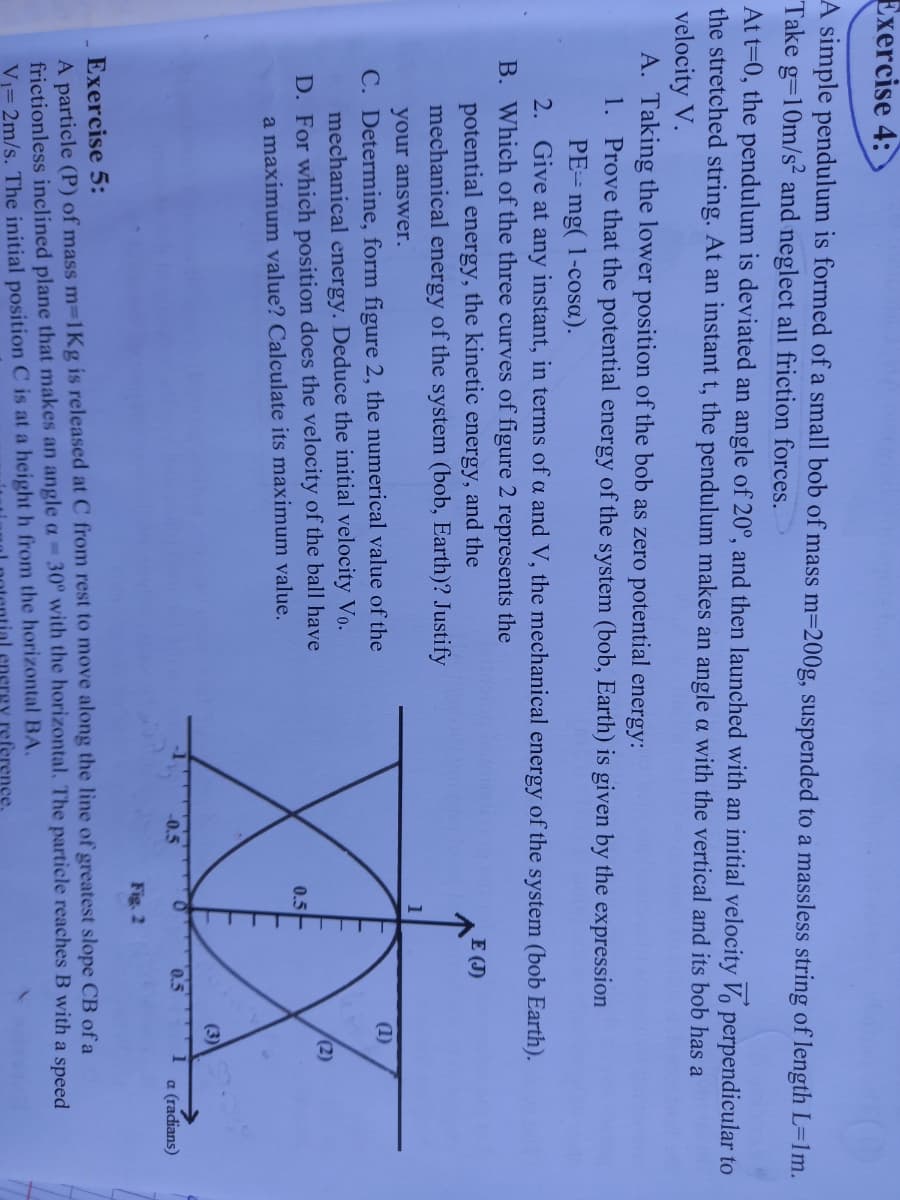(2) LXercise 4: A simple pendulum is formed of a small bob of mass m=200g, suspended to a massless string of length L=1m. Take g=10m/s² and neglect all friction forces. Att=0, the pendulum is deviated an angle of 20°, and then launched with an initial velocity Vo perpendicular to the stretched string. At an instant t, the pendulum makes an angle a with the vertical and its bob has a velocity V. A. Taking the lower position of the bob as zero potential energy: 1. Prove that the potential energy of the system (bob, Earth) is given by the expression PE- mg( 1-cosa). 2. Give at any instant, in terms of a and V, the mechanical energy of the system (bob Earth). B. Which of the three curves of figure 2 represents the E (J) potential energy, the kinetic energy, and the mechanical energy of the system (bob, Earth)? Justify 1 your answer. C. Determine, form figure 2, the numerical value of the mechanical energy. Deduce the initial velocity Vo. D. For which position does the velocity of the ball have (1) (2) 0.5 a maximum value? Calculate its maximum value. (3) -0.5 0.5 a (radians)
(2) LXercise 4: A simple pendulum is formed of a small bob of mass m=200g, suspended to a massless string of length L=1m. Take g=10m/s² and neglect all friction forces. Att=0, the pendulum is deviated an angle of 20°, and then launched with an initial velocity Vo perpendicular to the stretched string. At an instant t, the pendulum makes an angle a with the vertical and its bob has a velocity V. A. Taking the lower position of the bob as zero potential energy: 1. Prove that the potential energy of the system (bob, Earth) is given by the expression PE- mg( 1-cosa). 2. Give at any instant, in terms of a and V, the mechanical energy of the system (bob Earth). B. Which of the three curves of figure 2 represents the E (J) potential energy, the kinetic energy, and the mechanical energy of the system (bob, Earth)? Justify 1 your answer. C. Determine, form figure 2, the numerical value of the mechanical energy. Deduce the initial velocity Vo. D. For which position does the velocity of the ball have (1) (2) 0.5 a maximum value? Calculate its maximum value. (3) -0.5 0.5 a (radians)
Elements Of Electromagnetics
7th Edition
ISBN:9780190698614
Author:Sadiku, Matthew N. O.
Publisher:Sadiku, Matthew N. O.
ChapterMA: Math Assessment
Section: Chapter Questions
Problem 1.1MA
Related questions
Question
Can u solve the whole question for me

Transcribed Image Text:Exercise 4:
A simple pendulum is formed of a small bob of mass m=200g, suspended to a massless string of length L=1m.
Take g=10m/s and neglect all friction forces.
At t=0, the pendulum is deviated an angle of 20°, and then launched with an initial velocity Vo perpendicular to
the stretched string. At an instant t, the pendulum makes an angle a with the vertical and its bob has a
velocity V.
A. Taking the lower position of the bob as zero potential energy:
1. Prove that the potential energy of the system (bob, Earth) is given by the expression
PE= mg( 1-cosa).
2. Give at any instant, in terms of a and V, the mechanical energy of the system (bob Earth).
B. Which of the three curves of figure 2 represents the
potential energy, the kinetic energy, and the
mechanical energy of the system (bob, Earth)? Justify
E (J)
XX
your answer.
C. Determine, form figure 2, the numerical value of the
mechanical energy. Deduce the initial velocity Vo.
D. For which position does the velocity of the ball have
a maximum value? Calculate its maximum value.
(1)
(2)
0.5
(3)
-0.5
0.5
a (radians)
Fig. 2
Exercise 5:
A particle (P) of mass m-1Kg is released at C from rest to move along the line of greatest slope CB of a
frictionless inclined plane that makes an angle a 30° with the horizontal. The particle reaches B with a speed
Vi= 2m/s. The initial position C is at a height h from the horizontal BA.
reference,
Expert Solution
This question has been solved!
Explore an expertly crafted, step-by-step solution for a thorough understanding of key concepts.
Step by step
Solved in 3 steps with 1 images

Knowledge Booster
Learn more about
Need a deep-dive on the concept behind this application? Look no further. Learn more about this topic, mechanical-engineering and related others by exploring similar questions and additional content below.Recommended textbooks for you

Elements Of Electromagnetics
Mechanical Engineering
ISBN:
9780190698614
Author:
Sadiku, Matthew N. O.
Publisher:
Oxford University Press

Mechanics of Materials (10th Edition)
Mechanical Engineering
ISBN:
9780134319650
Author:
Russell C. Hibbeler
Publisher:
PEARSON

Thermodynamics: An Engineering Approach
Mechanical Engineering
ISBN:
9781259822674
Author:
Yunus A. Cengel Dr., Michael A. Boles
Publisher:
McGraw-Hill Education

Elements Of Electromagnetics
Mechanical Engineering
ISBN:
9780190698614
Author:
Sadiku, Matthew N. O.
Publisher:
Oxford University Press

Mechanics of Materials (10th Edition)
Mechanical Engineering
ISBN:
9780134319650
Author:
Russell C. Hibbeler
Publisher:
PEARSON

Thermodynamics: An Engineering Approach
Mechanical Engineering
ISBN:
9781259822674
Author:
Yunus A. Cengel Dr., Michael A. Boles
Publisher:
McGraw-Hill Education

Control Systems Engineering
Mechanical Engineering
ISBN:
9781118170519
Author:
Norman S. Nise
Publisher:
WILEY

Mechanics of Materials (MindTap Course List)
Mechanical Engineering
ISBN:
9781337093347
Author:
Barry J. Goodno, James M. Gere
Publisher:
Cengage Learning

Engineering Mechanics: Statics
Mechanical Engineering
ISBN:
9781118807330
Author:
James L. Meriam, L. G. Kraige, J. N. Bolton
Publisher:
WILEY